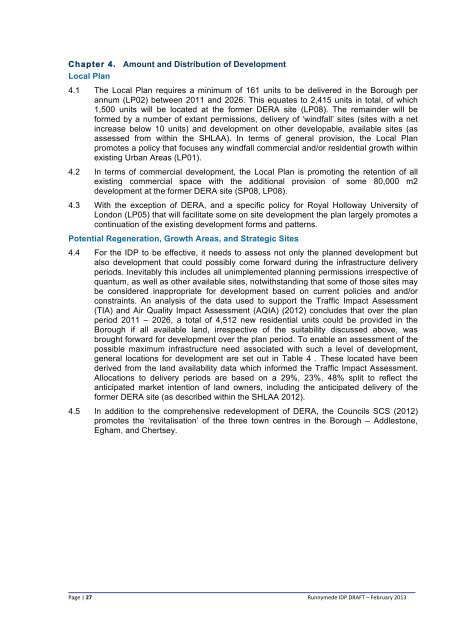Infrastructure Delivery Plan (Feb 2013) - Runnymede Borough Council
Infrastructure Delivery Plan (Feb 2013) - Runnymede Borough Council
Infrastructure Delivery Plan (Feb 2013) - Runnymede Borough Council
Create successful ePaper yourself
Turn your PDF publications into a flip-book with our unique Google optimized e-Paper software.
Chapter 4. Amount and Distribution of Development<br />
Local <strong>Plan</strong><br />
4.1 The Local <strong>Plan</strong> requires a minimum of 161 units to be delivered in the <strong>Borough</strong> per<br />
annum (LP02) between 2011 and 2026. This equates to 2,415 units in total, of which<br />
1,500 units will be located at the former DERA site (LP08). The remainder will be<br />
formed by a number of extant permissions, delivery of ‘windfall’ sites (sites with a net<br />
increase below 10 units) and development on other developable, available sites (as<br />
assessed from within the SHLAA). In terms of general provision, the Local <strong>Plan</strong><br />
promotes a policy that focuses any windfall commercial and/or residential growth within<br />
existing Urban Areas (LP01).<br />
4.2 In terms of commercial development, the Local <strong>Plan</strong> is promoting the retention of all<br />
existing commercial space with the additional provision of some 80,000 m2<br />
development at the former DERA site (SP08, LP08).<br />
4.3 With the exception of DERA, and a specific policy for Royal Holloway University of<br />
London (LP05) that will facilitate some on site development the plan largely promotes a<br />
continuation of the existing development forms and patterns.<br />
Potential Regeneration, Growth Areas, and Strategic Sites<br />
4.4 For the IDP to be effective, it needs to assess not only the planned development but<br />
also development that could possibly come forward during the infrastructure delivery<br />
periods. Inevitably this includes all unimplemented planning permissions irrespective of<br />
quantum, as well as other available sites, notwithstanding that some of those sites may<br />
be considered inappropriate for development based on current policies and and/or<br />
constraints. An analysis of the data used to support the Traffic Impact Assessment<br />
(TIA) and Air Quality Impact Assessment (AQIA) (2012) concludes that over the plan<br />
period 2011 – 2026, a total of 4,512 new residential units could be provided in the<br />
<strong>Borough</strong> if all available land, irrespective of the suitability discussed above, was<br />
brought forward for development over the plan period. To enable an assessment of the<br />
possible maximum infrastructure need associated with such a level of development,<br />
general locations for development are set out in Table 4 . These located have been<br />
derived from the land availability data which informed the Traffic Impact Assessment.<br />
Allocations to delivery periods are based on a 29%, 23%, 48% split to reflect the<br />
anticipated market intention of land owners, including the anticipated delivery of the<br />
former DERA site (as described within the SHLAA 2012).<br />
4.5 In addition to the comprehensive redevelopment of DERA, the <strong>Council</strong>s SCS (2012)<br />
promotes the ‘revitalisation’ of the three town centres in the <strong>Borough</strong> – Addlestone,<br />
Egham, and Chertsey.<br />
Page | 27<br />
<strong>Runnymede</strong> IDP DRAFT – <strong>Feb</strong>ruary <strong>2013</strong>
















